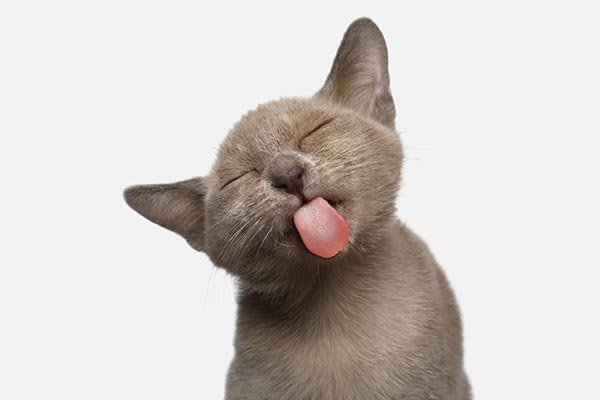Hairballs in Cats: 5 Things to Know

Cats work hard for their beautiful, shiny coats, cleaning and grooming themselves with their tongues. This natural grooming behavior may make kitty look pretty, but it comes at a price. The fur that sheds off as they groom themselves inevitably gets swallowed. That fur doesn’t digest, and if it doesn’t pass through their system in one direction, it has to come up in the form of hairballs.
Read on to learn five things about hairballs in cats.
Hairball Fact No. 1: Hairballs Are Normal, And Usually Harmless
Hairballs are a normal fact of life with cats. All cats spit them up from time to time (well, with on exception—Sphinx cats, also known as hairless cats do not) and it’s usually not a problem. Think of a cat expelling a hairball as you would unclog a shower drain; some of the hair goes down and out through the pipes, where some may get stuck, gathering up into a mass. It needs to come out.
Most of the time, it is an easily remedied problem. Hearing and seeing your cat expel a hairball can be unnerving, but rest assured, it’s completely normal.
Hairball Fact No. 2: Some Cats Are More Prone To Hairballs Than Others
Going back to our shower drain reference, it’s pretty easy to figure out which types of cats may be more prone to hairballs. Long-haired breeds like Persian, Himalayan, or Ragdoll cats who have more hair to deal with will be more likely than shorter haired breeds.
Older cats are also more likely to get hairballs than kittens, as they have more fur and are more meticulous and efficient groomers.
Hairball Fact No. 3: Hairballs Are Seasonal (mostly)
When you think of seasonal allergies, your cat is thinking hairballs. As winter (finally) leaves the midwest, cats begin shedding their winter coats. This can lead to more hairball situations than any other time of year.
Hairball Fact No. 4: Hairball Problems Have Common Symptoms
Hairballs may be a fact of cat life, but more than two a year can mean trouble. A cat’s digestive system should be able to handle a normal load of fur, most of the time. More than two hairballs a year, or any of the following symptoms are a cause for concern, and should be addressed by the veterinarian.- Unproductive Hacking, Retching, or Gagging - Your cat’s body knows when that hair needs to go, so it will try to bring it up and out if it isn’t taking the southern route. (Ahem.) You can try giving them a little butter, oil, or a commercially available hairball gel to move things along. Continual coughing or gagging sounds can signal other medical problems as well, so if it continues, see the vet.
- Changes in Bowel Movements - If kitty seems constipated, or conversely has frequent bouts of diarrhea, there may be a hairball obstruction in their digestive tract.
- Distended, Bloated Looking Belly - A bloated, distended tummy is a relatively sure sign of a digestive tract obstruction and you should see the vet as soon as possible.
- Lethargy and Weight Loss - If your cat is moving around extra slowly, sleeping even more than usual, losing their appetite and/or losing weight, this is a sign kitty needs a trip to the vet ASAP.
Hairball Fact No. 5: Simple Preventative Care Can Reduce Hairball Troubles
There are some things you can do to help you cat have fewer hairballs. Brushing your cat’s fur regularly can help by removing excess fur, giving less for kitty to swallow as he grooms himself. Making sure your cat has plenty of water and a good, high protein diet.
Keeping well-hydrated and eating a high quality food will keep the digestive system working smoothly. Digestive supplements with psyllium seed, catnip, cat grass, and special hairball preventative treats that contain oils can help encourage the passage of hair.
If you feel your cat is having problems with clearing hairballs from their system, or if you have questions about preventing hairballs, connect with us at Academy Animal Hospital for an appointment.
